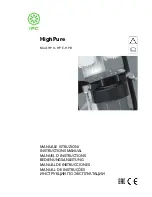
3
Operating Instructions and Parts Manual
24936
11/18
2018 OEMTOOLS
™
MANUAL FLUID EVACUATOR
2 GALLON (8 L)
PURPOSE
The OEMTOOLS™ 24936 Manual Fluid Evacuator is designed for
the extraction of all types of engine, transmission and lubricating oils
from cars, motorcycles, marine engines and industrial machinery. Also
suitable for low viscosity fluid such as water or coolant.
PRODUCT SPECIFICATIONS
Reservoir Capacity
2 Gallon (8 L)
Operation
Manual/Pneumatic
Application
Lubricating Oils, ATF, Coolant, Brake Fluid,
Water, Other Low Viscosity Fluids
SPECIFIC SAFETY INSTRUCTIONS
AND WARNINGS
CAUTION
:
This equipment is intended for professional use only
and only for the applications specified in in this manual.
CAUTION
:
DO NOT attempt to extract fluids at temperatures
greater than 175°F (80°C).
CAUTION
:
This equipment is designed for servicing a variety of
vehicles; however, differences in makes and models may not allow this
equipment to be used as intended by the manufacturer. DO NOT attempt
to force this equipment to fit an application for which it was not designed.
CAUTION
:
In addition to the guidelines set by this manual,
always follow the manufacturer provided vehicle maintenance manual
prior to attempting service of any kind.
WARNING
:
DO NOT use this equipment with gasoline or other
flammable liquids or with fluids at temperatures above 175°F (80°C).
WARNING
:
Keep away from open flames or excessive heat.
WARNING
:
To extract certain fluids, the vehicle may need to
be lifted. Practice extreme caution when using lifting equipment, and
ensure that the proper lifting equipment is utilized.
WARNING
:
Prior to inserting the extraction hoses into
any dipstick tube/fluid reservoir, ensure that the extraction hoses
are clean of any residual fluids. This could cause contamination,
potentially leading to system failure.
WARNING
:
This system creates a vacuum, thus creating
pressurized fluid. While operating, ensure secure fittings and always
check the system pressure prior to disconnecting any hose.
ASSEMBLY
The Main Extraction Reservoir is fully assembled.
1. Remove the unit and all pieces from the packaging.
2. Refer to the parts list to ensure all pieces are present.
3. Press the Main Suction Hose into the receiving hole on the
Reservoir Cap. Press in until snug against the cap. The O-Ring will
hold the Main Suction Hose in place during operation.
4. Ensure that the Reservoir Lid is properly secured to the Reservoir.
PREPARING FOR OPERATION
1. Park the vehicle on a level surface, free from obstruction. Put the
vehicle in park or neutral; apply the parking brake.
2. If extracting oil, start the engine and allow the engine to idle until it
has reached normal operating temperature. Turn the engine off.
NOTE
:
If extracting coolant, DO NOT follow Step 2. Allow the engine
to cool completely before proceeding.
EXTRACTING OIL THROUGH THE DIPSTICK TUBE
1. Insert the Dipstick Tube Adapter into the vehicle’s dipstick tube until
it reaches the bottom of the oil pan.
NOTE
:
DO NOT bend the Dipstick Tube Adapter while inserting the
adapter into the dipstick tube.
2. Connect the Main Suction Hose to the inserted Dipstick Tube Adapter.
NOTE
:
Ensure that the hose connections are tight to prevent leakage
during the extraction process.
3. Press the Main Suction Hose into the Reservoir Cap as described in
the assembly instructions.
NOTE
:
Ensure that the Vacuum Release Plug is fully inserted in the
lower receiving hole prior to operation. If the Vacuum Release Plug is
not inserted, a vacuum will not be created.
4. Pump the Evacuator Handle several times to create a vacuum. The
oil will flow through the Suction Hose Assembly into the Reservoir
until it has all been extracted OR until maximum reservoir capacity
has been reached.
5. Disconnect the Main Suction Hose from the Dipstick Tube Adapter.
6. Disconnect the Main Suction Hose from the Reservoir Cap. Pour
the used oil from the Reservoir into a suitable container. Dispose of
used oil in accordance with federal, state and local regulations.
EXTRACTING COOLANT FROM A RADIATOR
OR EXPANSION TANK
WARNING
:
DO NOT remove the cap from the radiator or
expansion tank while the engine is at operating temperature. This
system is under pressure and could cause serious injury. ALWAYS
allow the engine to cool completely prior to removing the radiator
cap or expansion tank cap.
1. See “Preparing for Operation” instructions above. Allow the engine
to cool completely.
2. Remove the radiator or expansion tank cap.
3. Insert the appropriate diameter Suction Hose Adapter into the
radiator or expansion tank until it reaches the bottom.
NOTE
:
DO NOT bend the Suction Hose Adapter while inserting the
Hose Adapter into the radiator.
4. Connect the Main Suction Hose to the inserted Suction Hose Adapter.
NOTE
:
Ensure that the hose connections are tight to prevent leakage
during the extraction process.
5. Press the Main Suction Hose into the Reservoir Cap as described in
the assembly instructions.
NOTE
:
Ensure that the Vacuum Release Plug is fully inserted in the
lower receiving hole prior to operation. If the Vacuum Release Plug is
not inserted, a vacuum will not be created.
6. Pump the Evacuator Handle several times to create a vacuum.
The coolant will flow through the Suction Hose Assembly into the
Reservoir until it has all been extracted OR until maximum reservoir
capacity has been reached.
7. Disconnect the Main Suction Hose from the Suction Hose Adapter.
8. Disconnect the Main Suction Hose from the Reservoir Cap. Pour the
used coolant from the Reservoir into a suitable container. Dispose of
used coolant in accordance with federal, state and local regulations.
EXTRACTING BRAKE FLUID FROM THE
MASTER CYLINDER
1. See “Preparing for Operation” instructions above.
2. Clean the exterior of the master cylinder and master cylinder cap to
prevent dirt and debris from entering the master cylinder when the
cap is removed.






















